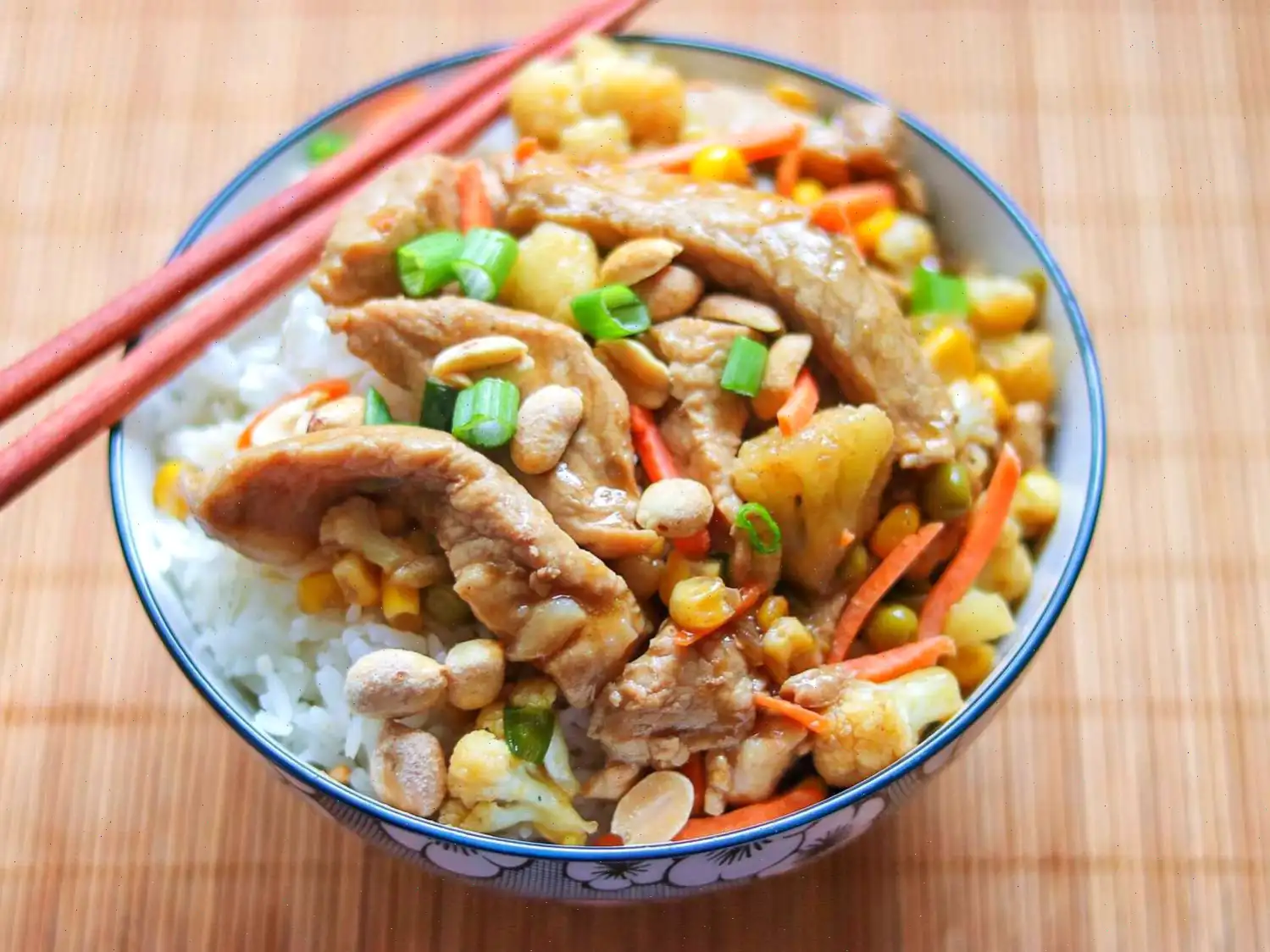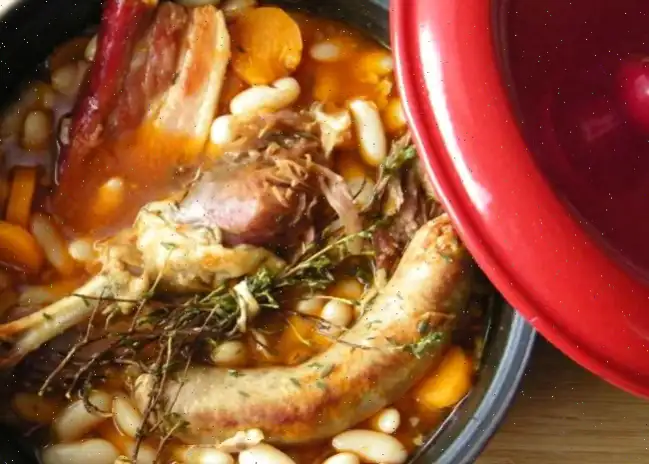
Pork Chop Stir-Fry Recipe
Pork chops might not be your first thought for stir-fries, but this pork chop stir-fry certainly rivals other versions of the dish. This recipe also uses plenty of vegetables including fresh cauliflower and carrots, frozen corn and peas, and some green onions that go in with your seasonings. But, of course, you can always add more veggies.
Step 1: Cut your boneless pork chops into strips, just as you would for a beef stir-fry. Once the pork is in the pan, add in garlic, ginger, green onions, and chili powder. Fry the pork until it is no longer pink.
Step 2: The sauce is what brings the most flavor to this recipe. After removing your pork and veggies from the pan, add in water, soy sauce, honey, and chicken bouillon to enhance the flavor of the meat.
Step 3: Prepare a slurry by mixing cold water and cornstarch. Gradually add the slurry to the skillet, stirring constantly as it comes to a boil. Let it cook and thicken for about 2 minutes.
Step 4: Return the pork and vegetables to the skillet and cook until everything is heated through. Stir in salted peanuts and serve the stir-fry over hot cooked rice. The result is a warm, savory dish packed with flavor.
Step 5: Serve immediately, and enjoy a satisfying meal that brings together tender pork, fresh veggies, and a deliciously sweet-savory sauce.
Ingredients:
- 3 tablespoons vegetable oil, divided
- 3 cups small cauliflower florets
- 2 medium carrots, julienned
- 1 cups frozen corn, thawed
- cup frozen peas, thawed
- 1 pound boneless pork chops, cut into stir-fry strips
- 2 stalks green onions, thinly sliced
- 2 cloves garlic, minced
- teaspoon ground ginger
- teaspoon chili powder
- 1 cup water
- cup soy sauce
- 4 teaspoons honey
- 2 teaspoons chicken bouillon granules
- 2 tablespoons cold water
- 4 teaspoons cornstarch
- cup salted peanuts
- 3 cups hot cooked rice
Directions:
Step 1: Heat 2 tablespoons of vegetable oil in a large skillet over medium-high heat. Add cauliflower florets and stir-fry for 2-3 minutes. Add carrots and stir-fry for another 2 minutes. Then, add the thawed corn and peas and cook until the vegetables are crisp-tender, about 2 minutes. Once done, remove all the veggies to a bowl and keep warm.
Step 2: In the same skillet, add the remaining 1 tablespoon of oil. Add the pork strips and stir-fry for 2 minutes. Then, add the green onions, garlic, ginger, and chili powder. Fry everything until the pork is no longer pink, about 2-3 minutes. Remove the pork from the skillet and keep it warm.
Step 3: In the skillet, combine 1 cup of water, soy sauce, honey, and chicken bouillon. Stir together 2 tablespoons of cold water and cornstarch in a small bowl, then gradually add this mixture to the skillet. Stir constantly while bringing it to a boil. Cook, stirring, until the sauce thickens, about 2 minutes.
Step 4: Return the cooked vegetables and pork back to the skillet. Stir everything together and cook until heated through. Finally, stir in the salted peanuts and mix everything well.
Step 5: Serve the stir-fry over hot cooked rice. Enjoy the sweet, savory, and crunchy goodness of this vibrant stir-fry dish.
Nutrition Facts (per serving):
- Calories: 478
- Total Fat: 21g (27% DV)
- Saturated Fat: 5g (24% DV)
- Cholesterol: 57mg (19% DV)
- Sodium: 877mg (38% DV)
- Total Carbohydrates: 47g (17% DV)
- Dietary Fiber: 5g (18% DV)
- Total Sugars: 9g
- Protein: 28g (57% DV)
- Vitamin C: 34mg (38% DV)
- Calcium: 53mg (4% DV)
- Iron: 3mg (15% DV)
- Potassium: 697mg (15% DV)
* Percent Daily Values are based on a 2,000 calorie diet. Your daily values may be higher or lower depending on your calorie needs.
Origins of Pork Chop Stir-Fry
Although stir-frying is strongly associated with traditional Chinese cuisine, the use of pork chops in this technique is a more modern adaptation. The method itself dates back over 1,500 years, evolving as a fast and efficient way to cook ingredients over high heat. As global trade expanded, pork became a favored protein for many Asian-inspired dishes, eventually giving rise to creative variations such as pork chop stir-fry. This dish bridges classic Asian cooking with Western cuts of meat, blending old culinary traditions with contemporary home-kitchen convenience.
Regional Variations
Across Asia, stir-fries differ widely based on local produce and seasoning styles. In Southern China, lighter sauces and crisp vegetables dominate, while Northern regions may lean toward bolder, saltier condiments. In Southeast Asia, cooks often incorporate citrus, chilies, and palm sugar for a bright, sweet heat. Western versions, such as this pork chop stir-fry, commonly feature pantry-friendly ingredients like soy sauce, honey, and mixed vegetables, making the dish adaptable to any regions seasonal produce.
How It Differs from Similar Dishes
Unlike classic pork stir-fries that use thinly sliced pork loin or shoulder, this recipe stands out for its use of pork chops cut into strips, which adds a distinctive texture and richer flavor. Additionally, the honey-soy sauce gives the dish a balanced sweet-savory profile, differentiating it from spicier or more vinegar-forward stir-fries. The addition of peanuts also introduces a subtle crunch not typically found in standard vegetable stir-fries.
Where It Is Commonly Served
Pork chop stir-fry is popular in home kitchens due to its quick preparation and simple ingredient list. It also appears in casual Asian-fusion restaurants that specialize in customizable stir-fry bowls. Because it pairs well with rice and everyday vegetables, it is often served as a weeknight dinner, a convenient meal-prep option, or a hearty dish at potlucks centered around family-style dishes.
Interesting Facts
Stir-frying is considered one of the most energy-efficient cooking methods, originally developed to conserve fuel. The technique also helps preserve the color, texture, and nutrients of vegetables, making dishes like pork chop stir-fry both vibrant and nutritious. Many chefs note that the secret to a successful stir-fry is in the preparation: ingredients should be pre-cut, pre-measured, and ready to add quickly. Another fun detail is that modern stir-fry sauces often blend influences from multiple cuisines, resulting in unique flavor combinations enjoyed worldwide.
You can listen to this recipe in AI audio format. Simply click the play button below to listen to the content in a format that suits you best. It’s a great way to absorb information on the go!
FAQ about Pork Chop Stir-Fry Recipe
Comments
Nicole Clark
01/25/2025 10:59:42 PM
This meal was fantastic! The only adjustments I made were adding approximately half a teaspoon of red pepper flakes and doubling the amount of honey. Additionally, I incorporated some ginger into my rice. I will definitely be making this again.
Emily Rodriguez
04/25/2023 01:24:05 PM
May I have a spoon, please?
Charles Lee
07/01/2024 10:20:36 PM
I was disappointed with this recipe. My sauce turned out more like teriyaki sauce, rather than the picture shown in the recipe. I would like to know how to make it look like the image. Is there a specific clear soy sauce that should be used?
Mark Williams
08/06/2023 12:30:07 PM
Excellent recipe that allows for easy substitution of vegetables if necessary. Quick, simple, and delicious.








